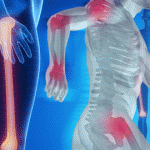CPT codes: 99213 Diagnosis Codes: ICD-9: 715.15, 278.01 ICD-10: M16.12, E66.01, Z68.41 This encounter is coded as 99213 as follows: History—The history of present illness was extended. The review of systems was comprehensive, and no past family social history was documented. This makes the history level expanded problem focused. Examination—There were eight systems examined. This…
Serum IGF-1 Tied to Fracture Risk in Elderly Women
NEW YORK (Reuters Health)—A Dutch study confirms that reduced serum levels of insulin-like growth factor-1 (IGF-1) are associated with increased fracture risk in elderly women, but not men. In an Aug. 31 online paper in the Journal of Clinical Endocrinology & Metabolism, Dr. N.C. van Varsseveld, of VU University Medical Center, Amsterdam, and colleagues noted that…

Small Grants Fund Physical Activity to Combat OA
To increase access to community-based physical activity for arthritis patients, the Osteoarthritis Action Alliance has awarded funding to three programs designed to implement evidence-based physical activity programs and osteoarthritis education in their communities…

Can Childhood Fitness Predict Adult Knee Problems or OA?
An Australian study found an association between child physical performance measures and adult knee structures. The data, collected from three points in participants’ lives, revealed a link between childhood activity and adult tibial cartilage volume and bone area.
Growth Hormone Reduces Fractures in Women with Osteoporosis
NEW YORK (Reuters Health)—Growth hormone is associated with a decrease in fractures in women with postmenopausal osteoporosis even a decade after treatment ceases, researchers from Sweden report. “We were surprised and pleased to find that the patients had a reduced risk of fracture so many years after the growth hormone treatment was ceased,” Dr. Emily…

Vitamin C Derivative Promising Option for OA
New research in mice has found that treatment with a vitamin C derivative can effectively suppress the generation of mitochondrial superoxide, which plays a role in cartilage degeneration and the progression of osteoarthritis…
Knee Replacement May ‘Turn Back the Clock’ for Arthritis Pain
(Reuters Health)—Knee replacement surgery may significantly ease pain and improve leg function and quality of life in patients with osteoarthritis or rheumatoid arthritis (RA), a new study suggests. While surgery doesn’t restore the same level of comfort and function patients had in their younger years, before they developed arthritis, the authors write in the journal…
Short Time Between Pregnancies Linked to Osteoporosis
(Reuters Health)—Women who have pregnancies less than a year apart may have a greater risk for osteoporosis later in life than those who wait longer between babies, a study suggests. Researchers compared the reproductive histories of 239 postmenopausal women with osteoporosis to 298 similar women without thinning bones. Pregnancies no more than 12 months apart…
Some Placebos More Effective Than Others in Osteoarthritis
NEW YORK (Reuters Health)—Some placebos are more effective than others, and these differences can influence the apparent outcomes of clinical trials, according to a systematic review and meta-analysis of osteoarthritis trials. “More surprising than the fact that all placebos are not equal is the magnitude of that difference,” Dr. Raveendhara R. Bannuru, from Tufts Medical…

Abaloparatide-SC May Reduce Fractures for Osteoporosis & New FDA Safety Website
In a 25 month Phase 3 trial, abaloparatide-SC reduced the risk of new fractures in patients suffering from postmenopausal osteoporosis. Plus, the FDA launches a new drug safety website.
- « Previous Page
- 1
- …
- 30
- 31
- 32
- 33
- 34
- …
- 46
- Next Page »